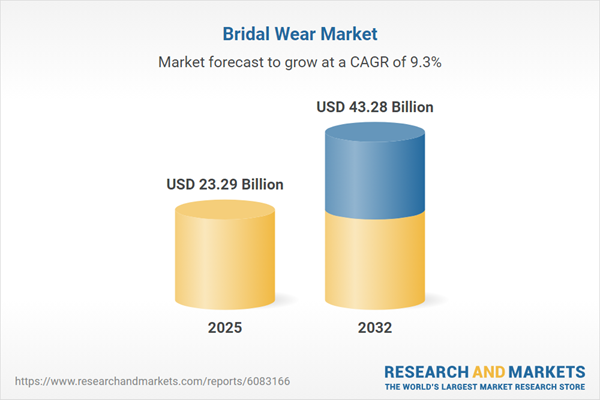Speak directly to the analyst to clarify any post sales queries you may have.
The bridal wear market is evolving rapidly, driven by changing consumer behaviors, rising expectations for sustainability, and transformative digital solutions shaping every stage of purchasing. Senior decision-makers must adapt to both shifting traditions and technological innovation to capture new opportunities and manage ongoing change.
Market Snapshot: Bridal Wear Market Growth and Opportunities
The Bridal Wear Market achieved growth from USD 21.27 billion in 2024 to USD 23.29 billion in 2025, and is forecast to reach USD 43.28 billion by 2032, reflecting a projected CAGR of 9.28%. This upward momentum underscores significant demand for innovation, extended geographic expansion, and the integration of digital platforms that enable tailor-made design choices and greater customer reach. Key drivers include heightened preferences for distinctive wedding attire, and the use of advanced digital tools improving design, customization, and global retail experiences.
Scope & Segmentation: Comprehensive Analysis of Bridal Wear
- Product Types: Includes bridal accessories such as footwear, headpieces, jewelry, and veils. Bridesmaid dresses in materials including chiffon, lace, and satin. Wedding gowns classified into bespoke, made-to-order, and ready-to-wear categories.
- Price Ranges: Captures the full spectrum from budget to luxury and mid-range offerings, addressing the diverse spending habits and demands for accessible as well as premium bridal solutions.
- Distribution Channels: Encompasses traditional bridal boutiques, department stores, online retailers, and specialty channels, emphasizing the strategic shift toward omnichannel models enabling flexible and cohesive shopping experiences.
- Age Groups: Segmentation covers customers under 25, ages 25–34, and 35 and above, presenting detailed insights on how preferences and purchasing power vary across key demographics.
- Dress Styles: Analyzes leading silhouettes such as A-line, ball gown, mermaid, and sheath, each informing ongoing product development and targeted marketing.
- Geographic Coverage: Examines the Americas (North America, Latin America), EMEA (Europe, Middle East, and Africa), and Asia-Pacific, with focus markets including China, India, Japan, Australia, South Korea, Indonesia, Thailand, Malaysia, Singapore, and Taiwan. This regional spread reveals the market’s dynamic nature across both mature and emerging regions, responding to diverse cultural preferences and growth patterns.
- Key Company Profiles: Includes leading brands such as David’s Bridal, Pronovias, Vera Wang Bridal House, Maggie Sottero Designs, BHLDN, Casablanca Bridal, Essense of Australia, Morilee, JLM Couture, and Amsale, with an emphasis on competitive positioning and innovation.
Technological advancements highlighted include virtual fitting tools that enhance online shopping, data-driven design for rapid trend response, circular sourcing to strengthen sustainability, and integrated omnichannel retail systems. These insights enable senior leaders to identify competitive advantages and align with operational best practices as the market landscape shifts.
Key Takeaways: Strategic Insights for Senior Decision-Makers
- Demand continues to move toward individualized experiences, environmental sensitivity, and seamless progression from online inspiration to offline purchase, requiring adaptive business models.
- Greater global digitalization supports broader market access, reduces traditional barriers, and streamlines product launches for faster brand responsiveness.
- Sustainability is an established market standard, with companies adopting traceable sourcing and circular design principles to align with new compliance norms and consumer values.
- Supply chain resilience improves through local production, near-shoring, and supplier diversification, ensuring adaptability in volatile trade environments and enhancing continuity.
- Collaboration with micro-influencers and capsule collection releases elevates digital engagement and builds relevance among digitally focused bridal communities.
Tariff Impact and Supply Chain Adjustments
The revision of United States tariff rates in 2025 has significantly influenced the cost structure for imported bridal gowns, accessories, and related fabrics. In response, many industry players have shifted toward enhanced local manufacturing and broader supplier networks. These tactical decisions increase agility and help minimize risks posed by geopolitical uncertainties and logistical constraints, supporting consistent access to key retail channels.
Methodology & Data Sources
This research utilizes qualitative interviews with designers and suppliers, structured end-user surveys, and a comprehensive review of secondary data from leading trade sources and industry publications. The analytical approach incorporates data triangulation alongside recognized frameworks such as PESTLE analysis and Porter’s Five Forces to ensure balanced and actionable market insights.
Why This Report Matters: Supporting Informed Decisions
- Supplies actionable, data-backed guidance for adapting to ongoing advances in sustainability, digital innovation, and shifting trade policies within the bridal wear sector.
- Identifies scalable growth and operational opportunities across multiple channels, customer demographics, and regional markets, positioning leaders for agile strategy development.
- Delivers robust segmentation, making it easier to anticipate emerging consumer demands, refine supply chains, and align cross-functional strategies for long-term stability.
Conclusion: Navigating the Bridal Wear Market Landscape
Success in the bridal wear market relies on harmonizing innovation with tradition, continuously strengthening digital and sustainable capabilities, and rapidly responding to market currents. Market participants equipped with timely insights are well positioned to foster customer loyalty and ensure sustained performance.
Table of Contents
3. Executive Summary
4. Market Overview
7. Cumulative Impact of Artificial Intelligence 2025
Companies Mentioned
The companies profiled in this Bridal Wear market report include:- David's Bridal, Inc.
- Pronovias S.A.
- Vera Wang Bridal House Ltd.
- Maggie Sottero Designs, LLC
- BHLDN, LLC
- Casablanca Bridal Ltd
- Essense of Australia Pty Ltd
- Morilee, LLC
- JLM Couture, Inc.
- Amsale, LLC
Table Information
| Report Attribute | Details |
|---|---|
| No. of Pages | 196 |
| Published | November 2025 |
| Forecast Period | 2025 - 2032 |
| Estimated Market Value ( USD | $ 23.29 Billion |
| Forecasted Market Value ( USD | $ 43.28 Billion |
| Compound Annual Growth Rate | 9.2% |
| Regions Covered | Global |
| No. of Companies Mentioned | 11 |









